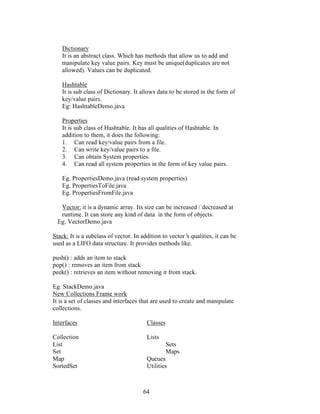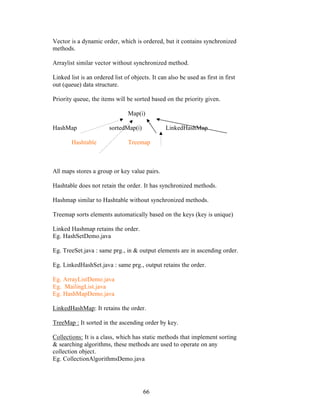Java is an object-oriented programming language introduced in 1995. It is platform independent and allows programs to run on any device with a Java Virtual Machine. The key features of Java include being simple, object-oriented, platform independent, robust, secure, distributed, multithreaded, and dynamic. Java programs are compiled into bytecode that can run on any platform supporting the Java Virtual Machine.
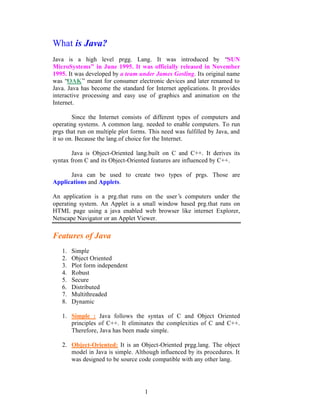




![6
Steps to execute a java prg:
? Open any editor such as notepad
? Type the source code
? Save it with .java extension (File Name and class name must be
same)
? Compile it
? Run it
Steps to compile a java prg:
? Open Dos prompt
? Install DOSKEY
? Set the path
Ex: path=c:jdk1.2.2bin and press enter key
? Move to your working directory/folder
? Compile the prg
Ex: javac filename.java
? Run the prg
? Ex: java filename
Note: jdk1.2.2 is the java’s installation directory. Some times it could be
jdk1.3 or other.
Doskey: it is a dos command, which maintain a history of commands
given by user. User can simply scroll through and use those commands by
pressing up arrow and down arrow.
In the Java prg:
public: It indicates that main() can be called outside the class.
static: It is an access specifier, which indicates that main() can be called
directly without creating an object to the class.
void: It indicates that the method main() doesn’t return a value.
main(): It is a method which is an entry point into the java prg. When you
run a java prg.main() is called first.
String args [ ]: String is a class, which belongs to java.lang package. It
can be used as a string data type in java.](https://image.slidesharecdn.com/javanotesww8-160422175718/85/JAVA-for-Every-one-6-320.jpg)
![7
args[]: It is an array of string type. It is used to store command line args.
System: It is a class, which belongs to java.lang package.
out: It is an output stream object, which is a member of System class.
println(): It is a method supported by the output stream object “out”. It is
used to display any kind of output on the screen. It gives a new line after
printing the output.
print(): It is similar to println(). But doesn’t give a new line after printing
the output.
Control Statements:
Def: To control the flow of execution of sequential instructions in a prg.
Those are called Control statements. Those are,
1. Conditional statements
2. Looping statements
3. Jumping statements
1. Conditional statements:
a. If statement
b. Switch statement
2. Looping statements: The block of statements are executed
specified no. of times or until the condition is unsatisfied. Those
are called Looping statements.
a. For
b. While
c. Do-while
3. Jumping statements: The control transfers from one location
to another in a prg. Those are called jumping statements.
a. Break
b. Continue
c. Return
d. Goto
Comments :](https://image.slidesharecdn.com/javanotesww8-160422175718/85/JAVA-for-Every-one-7-320.jpg)


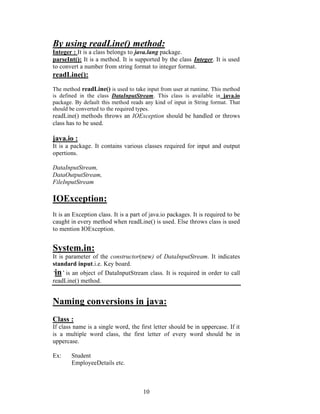
![11
Method/Function:
If method is a single word, it should be in lowercase. If it is a multiple
word, the first word is in lowercase and from second word onwards first
letter of every word should be in uppercase.
Ex: Read()
readLine()
parseInt()
itemValueChanged() etc.
Data Members(variables)
Naming conversions to variables is similar to that of methods.
Eg: marks
studentMarks
studentAverageMarks
rateOfInterest etc.
Note: If a word have bracket that is called Method or Data Member.
Arrays:
Collection of similar data elements and having a same name. Its elements
can be accessed by using an index or subscribed number which always
start from zero / zero based index.
Types of Arrays :
1) Single dimensional array
2) Multi dimensional array
Single dimensional array : it is an array with only one dimension. It can
be visualized as a single row or a column.
Declaration :
Datatype variable[]=new datatype[size];
Or
Datatype variable[];
Variable=new datatype[size];
Two dimensional array : It is an array with two dimensions. It can be
visualized as a matrix of rows and columns.
Declaration:
Datatype variable[][]=new datatype[rows][col];](https://image.slidesharecdn.com/javanotesww8-160422175718/85/JAVA-for-Every-one-11-320.jpg)
![12
Or
Datatype variable[][]
Variable=new datatype[row][col];
Sorting:
Sorting is a process of rearranging array elements (ascending or
descending). The following are the sorting techniques.
1. Selection sort
2. Bubble sort
1. Selection sort: In this technique, the first element is selected and
compared with all other elements. If any other element is less than
the first element swapping should take place.
By the end of this comparison, the least element most top position
in the array. This is known as pass1.
In pass II, the second element is selected and compared with all
other elements. Swapping takes place if any other element is less
than selected element. This process continuous until array is
sorted.
The no. of passes in array compare to size of array –1.
2. Bubble sort: This technique compares last element with the
preceding element. If the last element is less than that of preceding
element swapping takes place.
Then the preceding element is compared with that previous
element. This process continuous until the II and I elements are
compared with each other. This is known as pass 1.
This way the number of passes would be equal to size of array –1.
Class :
Syntax :
import statements ;
class classname
{
data members / variables;](https://image.slidesharecdn.com/javanotesww8-160422175718/85/JAVA-for-Every-one-12-320.jpg)
![13
methods / functions ;
}
syntax to creating an object :
classname objname = new classname ( ) ;
or
classname objname ;
objname = new classname ( ) ;
syntax to creating an array of objects :
classname arrayobj[] = new classname [ size];
constructors
1. It is a member function, whose name is same name of
class.
2. It can be with or without parameters.
3. It has no return type.
4. It is used to construct an object and it is used to initialize
data members.
5. It is also used to allocate memory to data members
6. It is invoked implicitly. Whenever an object is created.
Implicitly ? Automatically
Explicitly ? done by user
Syntax :
Classname objectname = new classname ( ) ;
Destructor:
1. It is a member function whose name is same as the class.
But preceded by a ~ (tilde) symbol.
2. It has no return type.
3. It cannot have parameters.](https://image.slidesharecdn.com/javanotesww8-160422175718/85/JAVA-for-Every-one-13-320.jpg)


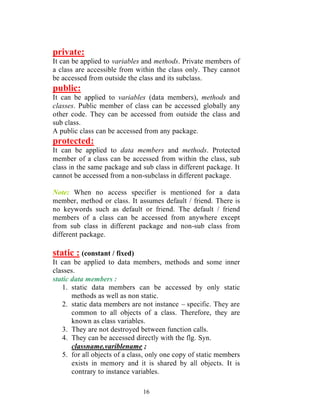
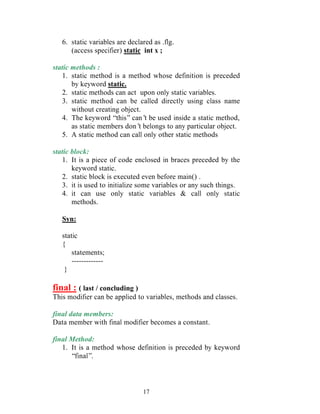





![23
Class A
{
}
class B extends A
{ }
Class C extends A
{ }
Constructors and Inheritance:
When both super and sub classes are having a constructor, on
creating an object for the subclass, base class constructor is
called first then subclasses constructors.
Eg.
Class base
{
public base()
{
statements ;
}
}
class derived extends base
{
public derived()
{
statements ;
}
}
class constructDemo
{
public static void main(String args[])
{
base b=new base();
} }](https://image.slidesharecdn.com/javanotesww8-160422175718/85/JAVA-for-Every-one-23-320.jpg)
![24
Method overriding :
It is a process of redefining a method of super class in sub
class. Thus one method can have many implementations.
Eg.
Class sample1
{
public void display()
{ }
}
class sample2 extends sample1
{
public void display()
{ }
}
class overriding
{
public static void main(String arags[])
{
sample2 s2 = new sample2();
s2.display();
super.display(); // calling the display() in sample1 class.
}
}
out put :
The display() in sample2 class is calling only.
The display() in sample1 class is calling.
Accessing methods of sub class through super class object.
It is possible to access methods of sub class by assigning sub
class’s object to base class reference.
Eg.
Class emp
{ }
class manager extends emp
{ }](https://image.slidesharecdn.com/javanotesww8-160422175718/85/JAVA-for-Every-one-24-320.jpg)
![25
class officer
{
p. s. v. m. (String args[])
{
emp e= new manager();
e.read();
e.display();
}
}
Dynamic method dispatch: (Dynamic Binding)
In java, base class reference can be assigned objects of sub
class. When methods of sub class object are called through base
class’s reference. The mapping / binding or function calls to
respective function takes place after running the program, at
least possible moment. This kind of binding is known as “late
binding” or “dynamic binding” or “runtime polymorphism”.
Eg.
class A
{
public void display()
{ }
}
class B extends A
{
public void display()
{ }
}
class C extends A
{
public void display()
{ }
}
class DispatchDemo
{
psvm (String args[])](https://image.slidesharecdn.com/javanotesww8-160422175718/85/JAVA-for-Every-one-25-320.jpg)



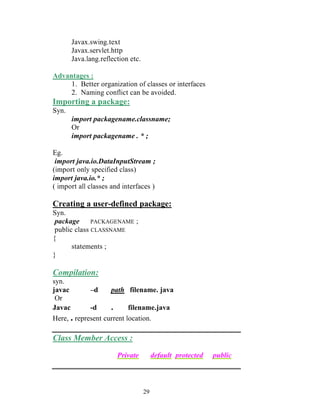




![34
IllegalArgumentException Argument is illegal.
MalFormedURLException URL is not well formed
SQLException SQL statement is not well.
Exception Generic Exception
IOException Input / output exception
IllegalAccessException class is not accessible
FileNotFoundException unable to locate a file.
* * *
user-defined exception:
When built-in exceptions do not meet our specific
requirements. We can define our own exception classes such
exceptions are known, as user-defined exception must extend
the base class exception.
Syn.
class classname extends Exception
{
}
Call Stack:
It is a stack, which stores fun calls in LIFO(Last In First Out)
manner.
Eg.
Class stackdemo
{
psvm(String args[]) {
doIt();](https://image.slidesharecdn.com/javanotesww8-160422175718/85/JAVA-for-Every-one-34-320.jpg)
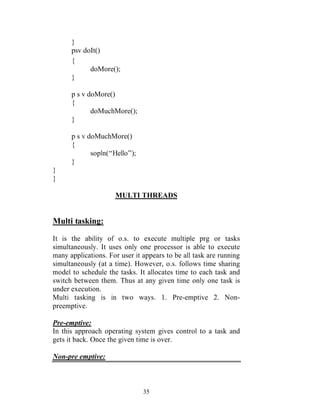




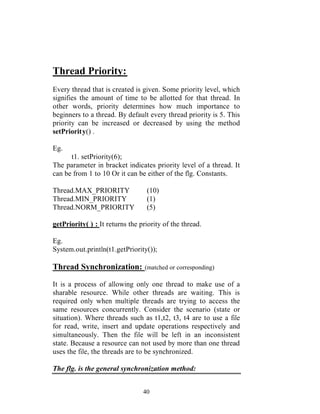

![42
Dead Lock :
It is a situation where two threads will have circular dependency. Java
serves this problem by releasing the locks.
STRING HANDLING
String is a group of characters. To manipulate strings java provides the
flg. classes.
1. String 2. StingBuffer
String:
It is used to create String objects. String objects are “immutable”. This
means that they can’t be modified. Though String is a class. It can be used
as a data type.
Eg.
String s = ”java”;
StringBuffer:
It is also used to create string objects. But these objects are mutable
(changeable). This means that they can be modified. It should be
instantiated as follows.
Eg.
StringBuffer s = new StringBuffer(“java”);
Constructors of String class:
String():
Creates a String object. Which is empty.
Eg.
String s = new String();
String (String str):
Creates a string object with given string.
Eg.
String s1= new String(“java”);
String s2=new String(s1);
String(char[] ch):
Creates a string object with given character array.
Eg.
Char ch={‘v’,’i’,’s’,’i’,’o’,’n’};
String s= new String (ch);](https://image.slidesharecdn.com/javanotesww8-160422175718/85/JAVA-for-Every-one-42-320.jpg)
![43
String (char ch[], int startindex, int numchar):
Creates a string object with from start index to num of characters of given
array.
Eg.
Char ch[]={‘v’,’i’,’s’,’i’,’o’,’n’};
String s= new String(ch,2,5);
Methods of String class:
charAt(int):
returns the character specified by the index..
Eg.
String s=”hello java”;
Char ch=s.charAt(4);
concat(String str):
It concatenates the given string with invoking string object and the result
is assigned to a new string.
Eg.
String s1= “Hello”;
String s2=”java”;
String s3=s1.concat(s2);
copyValueOf(char ch[]):
copies the given character array into a string object.
Eg.
char ch[]= {‘j’,’a’,’v’,’a’};
String s=String.copyValueOf(ch);
copyValueOf(char ch[], int startindex, int numchar):
Copies the given character array from start index to number of characters
into a string object.
Eg.
char ch[]= {‘j’,’a’,’v’,’a’};
String s=String.copyValueOf(ch,2,2);
endsWith(String str):
It returns true. If the invoking string object ends with given string.
Eg.
String s=”Welcome to java”;
boolean b=s.endsWith(“java”);](https://image.slidesharecdn.com/javanotesww8-160422175718/85/JAVA-for-Every-one-43-320.jpg)
![44
startsWith(String str):
It returns true. If the invoking string object starts with given string.
Eg.
String s=”Welcome to java”;
boolean b=s.startsWith(“java”);
equals(obj):
Returns true if the invoking string object and given object are equal.
Eg.
String s1= “java”;
String s2=”j2se”;
boolean b=s2.equals(s1);
equalsIgnoreCase(obj):
Returns true if the invoking string object and given object are equal. But it
ignores case.
getBytes():
Returns the invoking string object as a byte array.
Eg.
String s=”java”;
byte b[]= s.getBytes();
getChars(int startindex, int endindex, char ch[], int startindex):
it returns the invoking string object from start index to endindex to array
ch at specified index.
Eg.
String s=”welcome to java”;
Char ch[]=new char[20];
s.getChars(2,5,ch,0);
toLowerCase():
converts String object to lower case.
Eg.
String s=new String (“hello java”);
s.toLowerCase();
toUpperCase():
converts String object to upper case.
Eg.
String s=new String (“hello java”);](https://image.slidesharecdn.com/javanotesww8-160422175718/85/JAVA-for-Every-one-44-320.jpg)
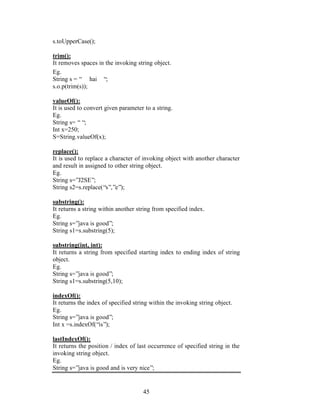
![46
Int x =s.lastIndexOf(“is”);
split():
It splits the invoking string object based on the criteria given as parameter
and the result is assigned to other string object.
Eg.
String s="hello, good, java";
String x[]=new String[5];
x=s.split(",");
for(int i=0;i<x.length;i++)
System.out.println(x[i]);
Output:
hello
good
java
replaceFirst():
Replaces the first occurance of the string (parameter1) other string
(parameter2) and result is assigned to another string object.
Eg.
String s=new String (“java is as good as any other language”);
String s1=s.replaceFirst(“as”, “very”);
StringBuffer:
This class is also used to manipulate strings. It objects are mutable. This
means that they can be modified. This class belongs to java.lang package.
Constructors of StringBuffer
StringBuffer():
It creates an empty string buffer object.
Eg.
StringBuffer s= new StringBuffer();
StringBuffer(int):
It creates a string buffer object with initial capacity is 16.
Eg.
StringBuffer s= new StringBuffer(16);](https://image.slidesharecdn.com/javanotesww8-160422175718/85/JAVA-for-Every-one-46-320.jpg)

![48
getChars(int startindex, int endindex, char target[], int target-
startindex):
It copies a substring of StringBuffer object from start index to end index
into target array.
Eg.
Char ch[]=new char[20];
SB= new SB(“hello, very good java”);
s.getChars(1,4,ch,0);
append(String str):
To append given string to the string buffer object.
Eg.
StringBuffer s=new StringBuffer(“Hello”);
s.append(“java”);
delete(int startindex, int endindex):
Deletes character of string buffer object from start index to end index.
Eg.
StringBuffer s=new StringBuffer(“hello java”);
s.delete(3,6);
deleteCharAt(int):
Deletes character at specified index.
Eg.
SB s=new SB(“j2me”);
s.deleteCharAt(2);
replace():
It is used to replace some text of string buffer object with given string.
Eg.
SB s=new SB(“Hello King java”);
s.repace(2,7,”vision”);
* * *
I/O Packages
The standard streams in java such as System.in, System.out and
System.err cannot deal all kinds of I/O. In order to create all kinds of I/O
operations, develops of java defined many classes meant for I/O. Those
classes are kept in a package by name java.io.](https://image.slidesharecdn.com/javanotesww8-160422175718/85/JAVA-for-Every-one-48-320.jpg)

![50
void mark() This method is used to marks the correct
position in the stream.
boolean markSupported() This method indicates whether the streams
supports mark and reset capabilities.
long skip(long n) This is method skips n bytes of input.
OutputStream class:
An abstract class that defines the way that which outputs are written to
streams.
This class is used to write data to stream.
Methods Purpose
Void write() This is the most fundamentals operations in
outputstream class the methods writes a byte. It can also write an array of
bytes.
Void flush () This method flushes the stream. The
buffered data is written to the output stream.
Void close() This methods closes the stream. It is used to
release any resource associated with the stream.
File Input Stream
Used to read input from a file in the form of stream.
Commonly used constructors of this class.
FileInputStream (String filename): creates an input stream that we can
used to read bytes from a file. Filename is full pathname of a file.
FileInputStream(File name): creates an input stream that we can use to
read bytes from a file. Name is a file object.
File Output Stream
This class is used to write output to a file stream. Its constructors are,
FileOutputStream (String filename): creates an output streams that we
can use to write bytes to a file.
FileOutputStream (File name): creates an output stream that we can use
to write bytes to a file.
FileOutputStream (String filename, boolean flag): creates an output
stream that we can use to write bytes to a file. If flag is true, file is
opened.
ByteArrayInputStream (byte b[],int start, int num): creates a byte
array input stream that begins with the character at start position and is
num bytes long.](https://image.slidesharecdn.com/javanotesww8-160422175718/85/JAVA-for-Every-one-50-320.jpg)





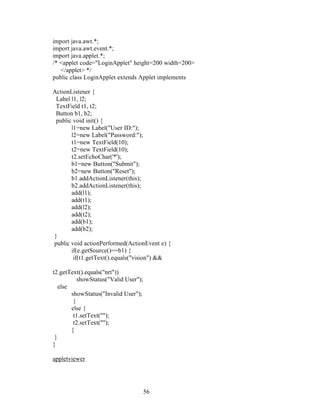
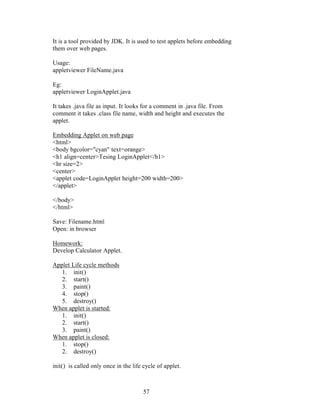
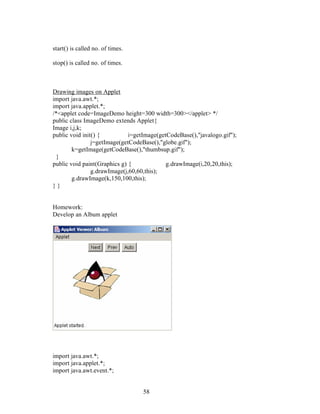
![59
/*<applet code=Album width=300 height=300> </applet> */
public class Album extends Applet implements ActionListener
{
Image img;
String
imgs[]={"boat.gif","box.gif","dukeplug.gif","globe.gif","javalogo.gif","m
agnify.gif"};
Button next,prev,auto;
int i,j;
public void init()
{
i=0;
img=getImage(getCodeBase(),imgs[0]);
next=new Button("Next");
prev=new Button("Prev");
auto=new Button("Auto");
add(next);
next.addActionListener(this);
add(prev);
prev.addActionListener(this);
add(auto);
auto.addActionListener(this);
setSize(300,300);
setVisible(true);
}
public void paint(Graphics g)
{
g.drawImage(img,50,50,this);
}
public void actionPerformed(ActionEvent e)
{
if(e.getSource()==next)
{](https://image.slidesharecdn.com/javanotesww8-160422175718/85/JAVA-for-Every-one-59-320.jpg)
![60
if(i<5)
i++;
else
i=0;
img=getImage(getCodeBase(),imgs[i]);
}
else if(e.getSource()==prev)
{
if(i>0)
{
i--;
}
else
{
i=5;
}
img=getImage(getCodeBase(),imgs[i]);
}
else if(e.getSource()==auto)
{
for(j=0;j<6;j++)
{
img=getImage(getCodeBase(),imgs[j]);
repaint();
}
}
repaint();
}
}
Passing parameters to an Applet
Runtime parameter can be passed to an applet. It is dine using <PARAM>
element within <APPLET> element.
import java.awt.*;
import java.applet.*;](https://image.slidesharecdn.com/javanotesww8-160422175718/85/JAVA-for-Every-one-60-320.jpg)



